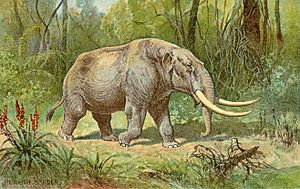Island 35 Mastodon facts for kids

The Island 35 Mastodon is the name given to the bones of a giant, ancient elephant-like animal found on Island No. 35 in Tipton County, Tennessee. These amazing bones were found in 1900. The site where they were discovered was about 3 miles east of Reverie, Tennessee. Sadly, the discovery site itself was later destroyed by natural forces in 1957.
Contents
What are Mastodons?
Mastodons were huge, ancient animals that looked a lot like today's elephants. They are part of an extinct group called Mammut. This means they are no longer alive on Earth.
- Where they lived: Mastodons lived all over North America.
- When they lived: They roamed the continent for a very long time, starting almost 4 million years ago during the Pliocene Epoch. They disappeared about 10,000 years ago.
Discovery of the Island 35 Mastodon
In 1900, an archaeologist named James K. Hampson recorded the discovery of mastodon bones. These bones were found on Island No. 35 in the Mississippi River, in Tipton County, Tennessee. The spot where they were found was about 3 miles east of Reverie, Tennessee.
How the Bones Were Found
In June 1900, there was a lot of heavy rain. This rain washed away sand on Island No. 35. When the water went down in July, the mastodon bones were uncovered in the dirt.
A local resident named John Pendleton found the unusual bones. He told his neighbor, James K. Hampson, about them. Hampson visited the site a few weeks after the bones were first seen.
Challenges at the Discovery Site
By the time Hampson arrived, many of the bones were already gone. People who were just curious or looking for ivory had taken parts of the skeleton. The remaining bones were mostly from the back leg and hip area. Hampson had to use a pick to dig them out of the gravel and clay.
At first, people thought all the bones came from just one mastodon. However, later studies showed that there were bones from at least two different mastodons at the site. Some human tools were also found nearby. But experts believe these tools were not directly related to early humans hunting or interacting with these mastodons.
Where are the Bones Today?
The original discovery site on Island No. 35 was reported as destroyed in 1957. This means the natural forces of the river likely washed it away.
The remaining mastodon bones are now on display for everyone to see. You can find them at the Hampson Archeological Museum State Park. The Tipton County Museum in Covington, Tennessee, also has some fossilized mastodon bones on exhibit.
Images for kids
-
Femur fragment of the Island 35 Mastodon at Hampson Archeological Museum State Park.



